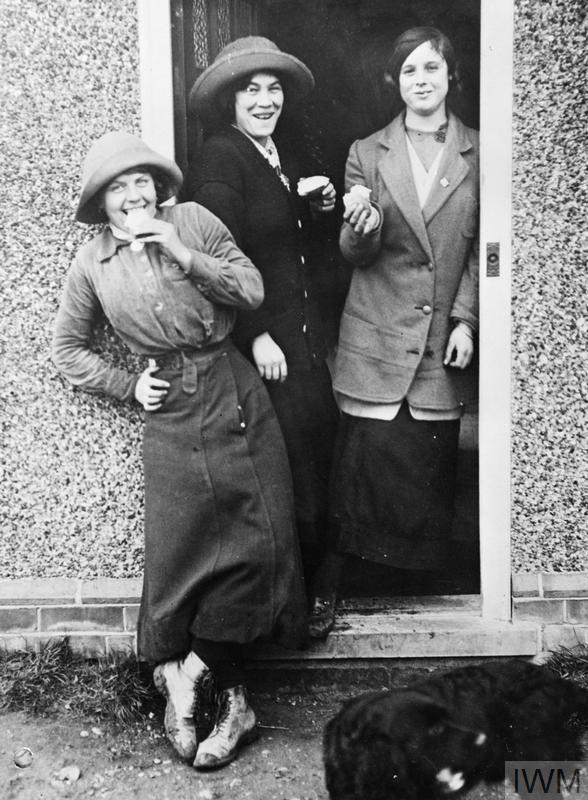
Former factory workers brought back to the land in the Radlett Experiment of the Central Committee on Women’s Employment ©IWM (Q 108488) http://www.iwm.org.uk/collections/item/object/205351270
Contributed by Julie Moore
In my previous piece, I mentioned an article written by Dr. Nicola Verdon on village women and their work on farms during the First World War. I am familiar with her research as I have worked on late 19th century and early 20th century farming for some years now, and keeping up with the latest research is a necessary part of my own research routine.
Food and farming are the histories on which I have spent most time and it is where my interest in the stories of ‘anonymous’ women first developed. However, I am now very much aware that I am moving beyond the familiar to grapple with more detailed work on women’s history: it is this aspect of research which I find myself thinking about quite frequently at the moment.
Taking up a new area of research is exciting as I have to think about new questions and look at my material in a different light. But what is new territory for me is certainly not unexplored. How ever much I know about agriculture, a fresh angle requires me to catch up on what those familiar with this territory might think was pretty basic information, in much the same way that the intricacies of farm accounts might baffle the most experienced historians of domestic labour or the fight for the right to vote.
The field of women’s history is very fortunate in its historians as any search for books and articles on this area will discover; far too many to name here, but just within the AHRC First World War Engagement Centres, Professor Maggie Andrews, from the ‘Voices of War and Peace’ Centre and consultant historian to Radio 4’s Home Front series, has worked with community groups and researchers uncovering stories of women’s domestic and working lives, most recently exploring the ways in which women from Worcestershire took on positions of power both during and after the war . In our own ‘Everyday Lives in War’ Centre, Professor Karen Hunt continues to research the role played by women in areas around food control, monitoring prices, organising local initiatives and taking to the streets when necessary.
In naming just these two women I am conscious of all those others whose work on this area is proving so fruitful in bringing women’s stories to the fore, and this raises in my mind a question of ‘is there anything new to contribute to the conversation?’
I believe that my experiences will chime with those of other community historians; that initial excited enthusiasm for a subject which raises all sorts of possibilities for questions to ask, sources to explore, stories to discover. However, once embarked on the hunt for answers, doubt can set in. Will I just be discovering what others have already found? Are these new stories just new to me? What will those who have spent many years working in this area think of me – and my ignorance? Should I stick with what I know? These questions can all come under the heading of ‘Imposter syndrome’ and of course it’s not a concept confined to historians. Putting your/my head above the parapet and asking to be included in that community of research is scary, so should it be risked?
Well, for good or ill, my answer is ‘yes’. In some ways, I am more fortunate than other community researchers as I get the opportunity to share my ideas with fantastic colleagues within the University of Hertfordshire’s History department, whose areas of interest cover a wide range of historical periods and themes. With their support, I get to talk through the issues, discover new ideas and build confidence.
I am aware that very many community historians work in isolation, and so I would like to encourage you to get in touch so we might support each other. I don’t have all the answers but I do have access to a network of people who might be able to help on specific questions.
More importantly, I feel, is that if you are going through similar feelings to my own at present – have something you would like to work on but are fearful of being laughed at/dismissed/ignored then get in touch and perhaps we can start building our own support network. There are a lot of us interested in the stories of how women like us experienced the First World War, women who have been largely forgotten, and it would be good to connect those stories and the researchers uncovering them.
I will say that in my experience historians are a generous bunch and any stories that we can bring to light will be welcomed both as adding to the body of knowledge, but also as offering new insights into the subject about which they are passionate. Let’s see how we can help bring more detail to the picture which they have already drawn for us.
If you would like to get in touch then email me at j.p.2.moore@herts.ac.uk and we can start the conversation ball rolling.
Oh, and that photo at the start of this piece is there for no other reason than I like it and it continues that sub-theme of ladies who smile for the camera. The girls shown here enjoying a break from their labours were unemployed factory workers from the East End of London. Uncertainty around what the war might mean for businesses saw many men and women laid off in those first months of fighting. Concern about alternative forms of work for girls in particular, led to initiatives to provide relief, including the setting up of the Central Committee on Women’s Employment. The girls in this picture were amongst a group sent out to Radlett in Hertfordshire to be trained in fruit farming. Once war industries offered girls such as these more lucrative work the committee stood down. You can see more images of the girls in unsuitable clothing and up to their ankles in mud on the Imperial War Museum website




